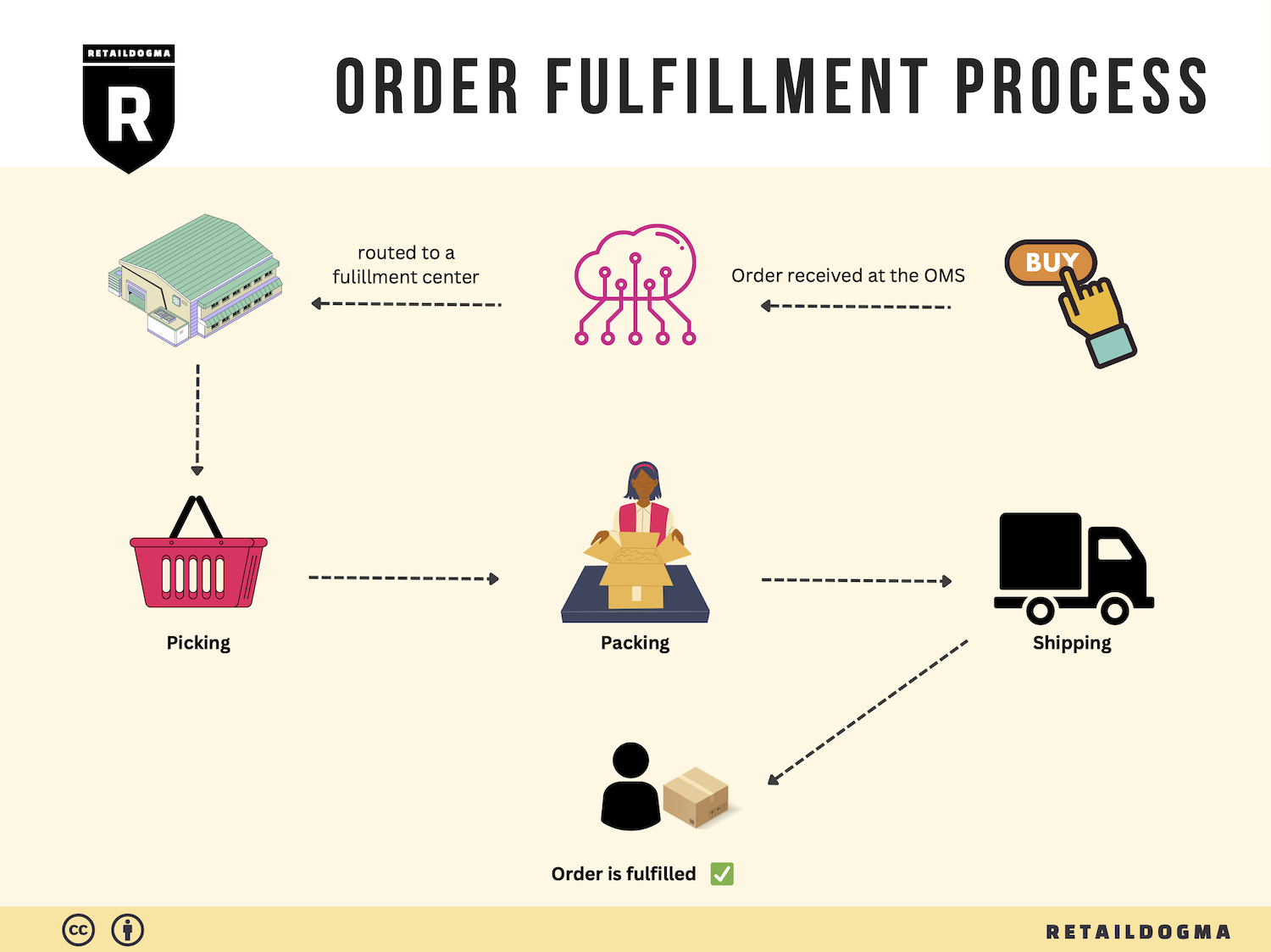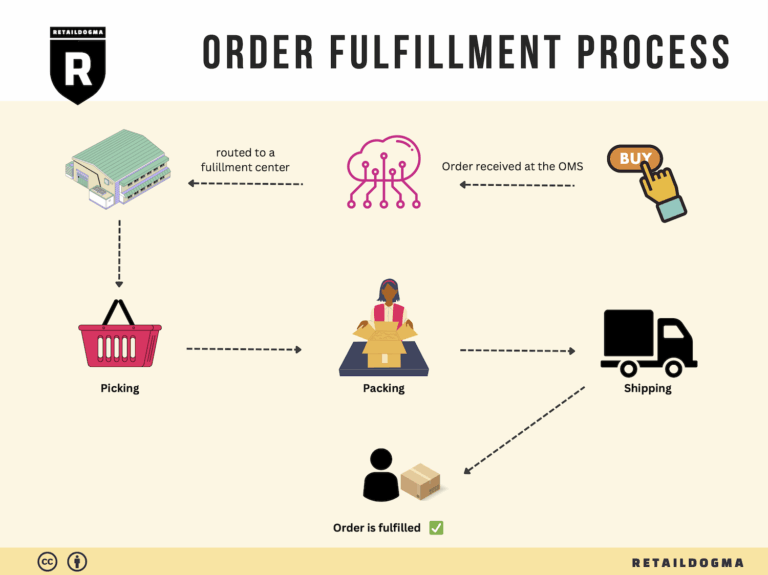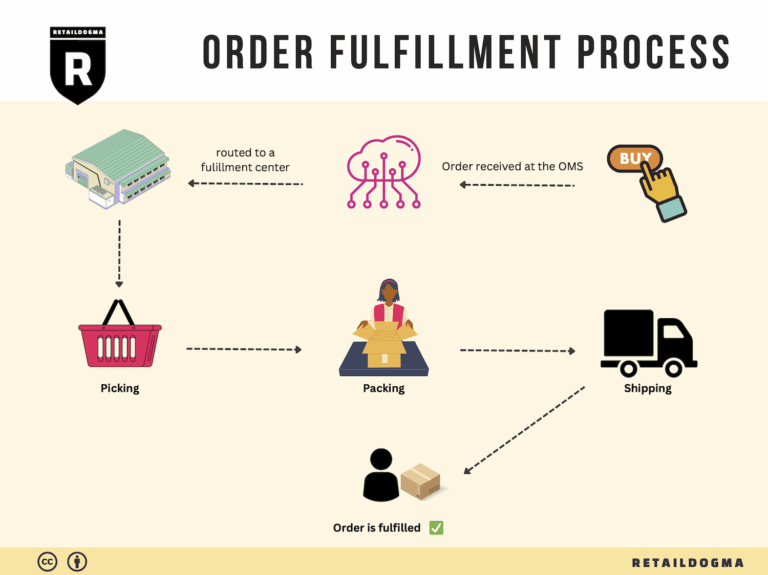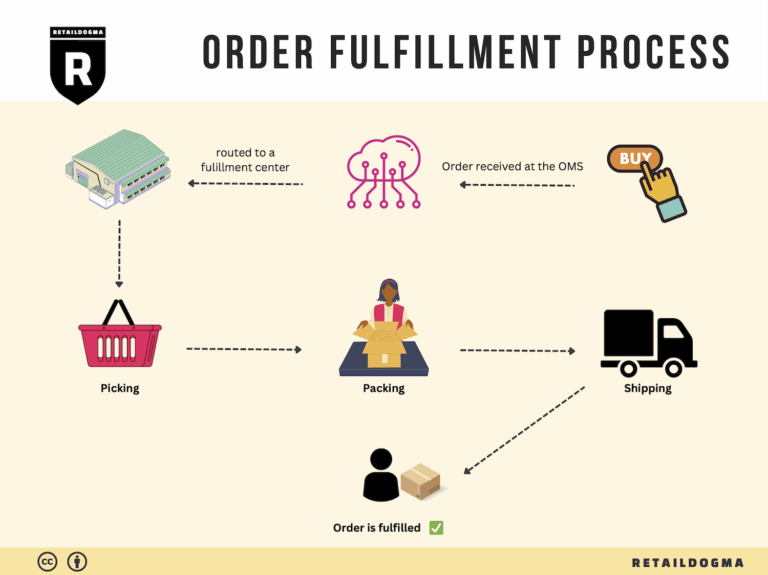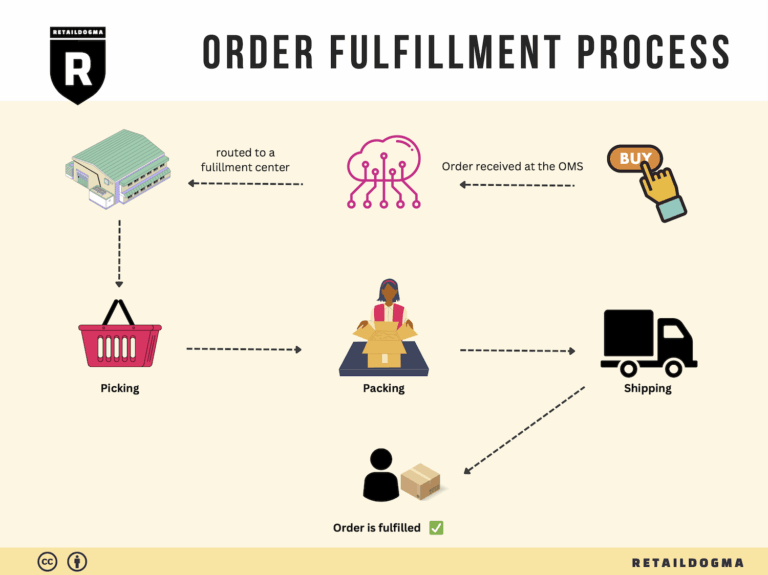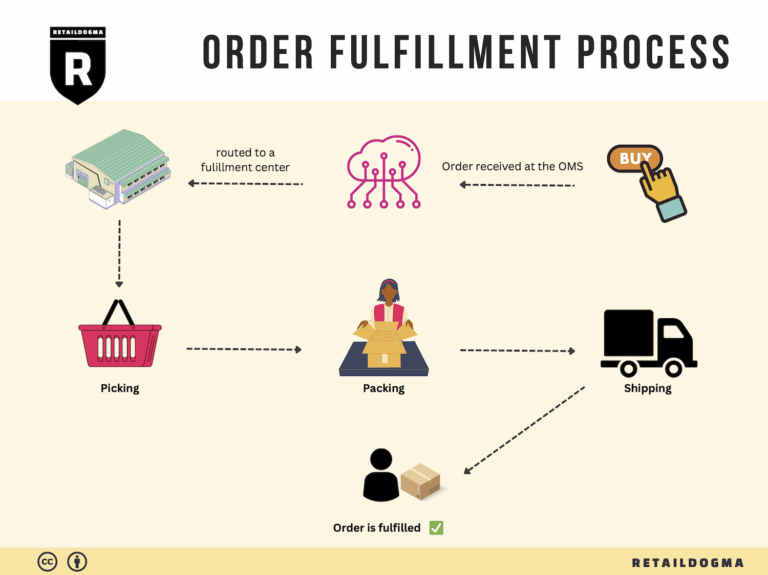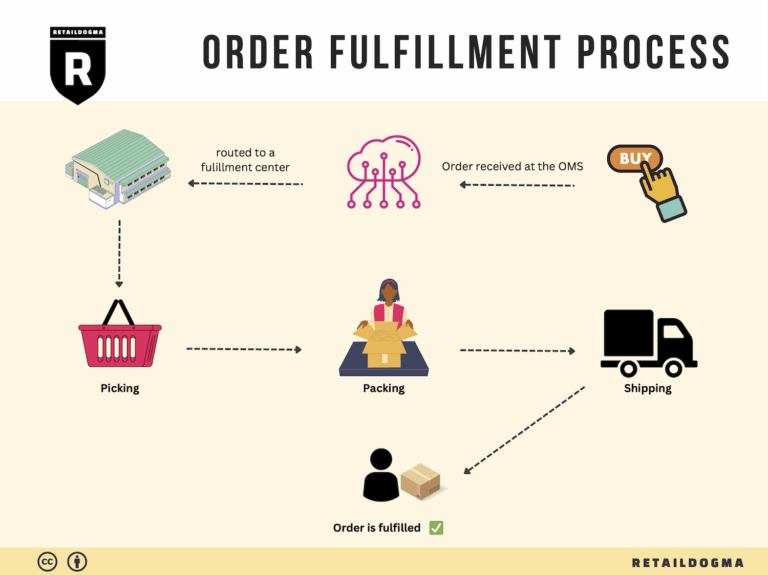What Is A Fulfillment Center? A Complete Guide (2025)
What is E-commerce Fulfillment? An Introduction for Growing Businesses
Understanding E-commerce Fulfillment: A Key to Scaling Your Business
As your online business grows, the excitement of increasing sales can quickly turn into the stress of managing logistics. One common pain point that many entrepreneurs face is feeling overwhelmed by the packing and shipping of orders. The process of getting a product from your warehouse to your customer’s doorstep can become a daunting task, especially when customer expectations for fast delivery continue to rise. This is where e-commerce fulfillment comes into play.
E-commerce fulfillment is essentially the process of receiving, processing, and delivering orders to customers. It encompasses everything from inventory management and order processing to packing and shipping. As your business scales, understanding the intricacies of fulfillment becomes crucial to maintaining customer satisfaction and operational efficiency.
In this guide, we will explore the various fulfillment models available to growing e-commerce businesses, including Third-Party Logistics (3PL) and Fulfillment by Amazon (FBA). Each model has its advantages and can be tailored to meet the specific needs of your business. We will break down the core services involved in fulfillment, such as storage, inventory management, order processing, and shipping, to give you a clearer picture of what to expect.
Choosing the right fulfillment partner can be a game-changer for your business. We’ll provide insights on how to evaluate potential partners, including key factors to consider such as reliability, technology capabilities, and customer service. Understanding pricing structures is also essential; we will discuss how to assess costs and find a partner that aligns with your budget and growth plans.
Ultimately, the goal of this guide is to empower you to make informed decisions about your logistics strategy. With the right fulfillment model and partner, you can streamline your operations, enhance customer satisfaction, and focus on what you do best—growing your business. By demystifying the fulfillment process, we aim to equip you with the knowledge needed to navigate this critical aspect of e-commerce successfully.
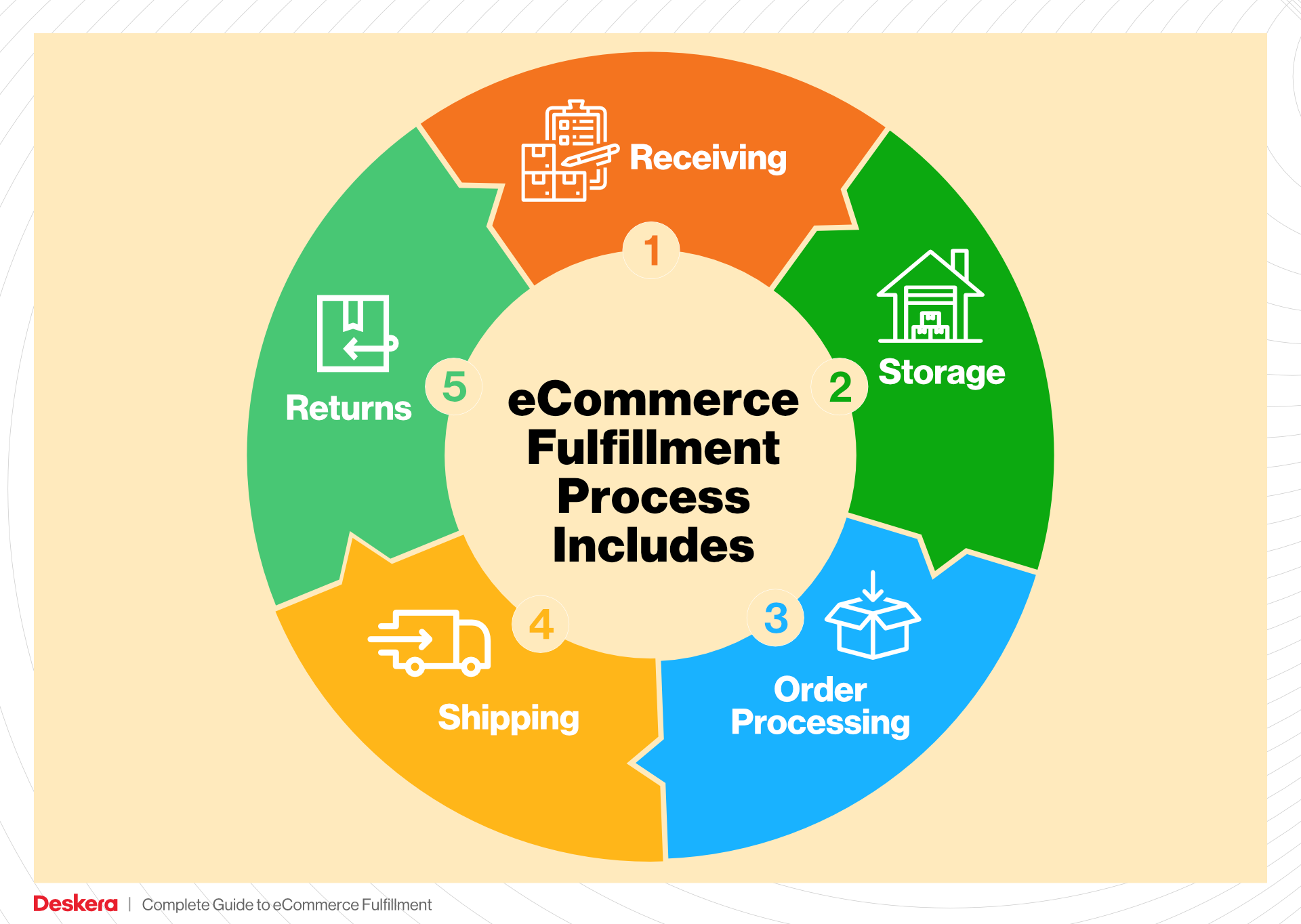
What You’ll Learn In This Guide
- What is E-commerce Fulfillment? An Introduction for Growing Businesses
- The Order Fulfillment Process: From ‘Buy’ Button to Customer’s Door
- Comparing Fulfillment Models: In-House vs. 3PL vs. Dropshipping
- A Deep Dive into Amazon FBA: Pros, Cons, and Who It’s For
- Core Services Offered by Fulfillment Centers
- How to Choose a Fulfillment Partner: A 6-Point Checklist
- Understanding Fulfillment Pricing: A Breakdown of Common Fees
- Frequently Asked Questions (FAQs) about Fulfillment
- Conclusion: Is Outsourcing Fulfillment the Right Move for Your Business?
- Important Disclaimer
The Order Fulfillment Process: From ‘Buy’ Button to Customer’s Door
1. Receiving Inventory
The order fulfillment process begins with receiving inventory at the fulfillment center. This step involves the acceptance of goods from suppliers or manufacturers. Upon arrival, the inventory is checked against purchase orders to ensure accuracy in quantity and quality.
Importance: This step is crucial as it sets the foundation for the entire fulfillment process. Any discrepancies can lead to stockouts or overstock situations, impacting sales and customer satisfaction.
Key Term: SKU (Stock Keeping Unit) – Each item is assigned a unique SKU for easy tracking and management within the inventory system. Properly labeling and entering SKUs into the system helps streamline subsequent steps in the fulfillment process.
2. Warehouse Storage
After receiving inventory, the next step is warehouse storage. Items are organized and stored in designated locations within the fulfillment center. Efficient storage systems, such as shelving or pallet racking, are utilized to maximize space and facilitate easy access.
Importance: Proper warehouse storage ensures that products are easily retrievable, reducing the time taken during order picking. An organized warehouse minimizes the risk of errors and helps maintain a smooth workflow.
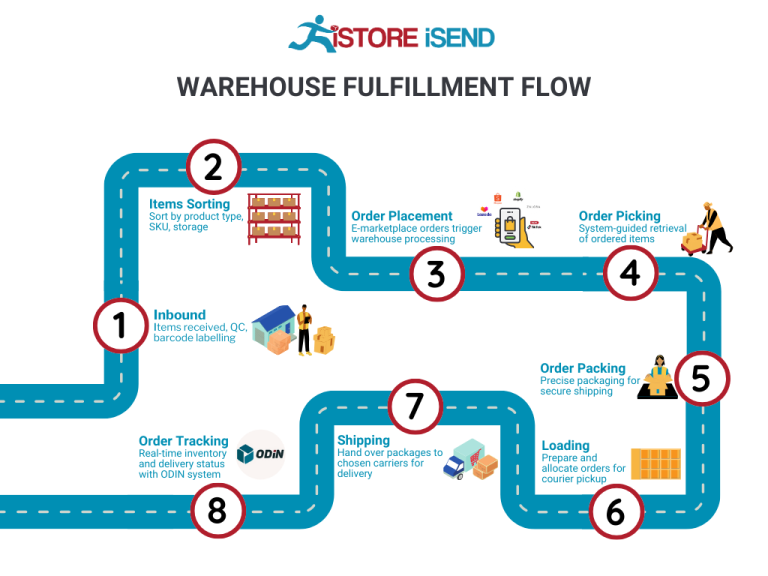
Key Term: ABC Analysis – This inventory categorization technique prioritizes items based on their demand frequency and value. High-demand items are placed in easily accessible locations, while lower-demand items may be stored further away, optimizing space and efficiency.
3. Order Picking
Once a customer places an order, the fulfillment process moves to order picking. This step involves retrieving items from their storage locations based on incoming orders. Warehouse staff use tools such as pick lists—documents that outline the items to be collected and their locations—to streamline this process.
Importance: Effective order picking is vital for timely order fulfillment. The speed and accuracy of this step directly influence customer satisfaction. Mistakes in picking can lead to incorrect orders, resulting in returns and increased operational costs.
Key Term: Batch Picking – This method involves picking multiple orders simultaneously, increasing efficiency, especially in high-volume environments. By grouping similar items, workers can reduce travel time and expedite the picking process.
4. Order Packing
After items are picked, they move to the order packing stage. During this step, products are carefully packed into boxes or containers, ensuring they are protected during transit. Packing stations are equipped with materials such as bubble wrap, packing peanuts, and tape to secure the items.
Importance: Proper packing is essential to prevent damage during shipping and to enhance the unboxing experience for customers. A well-packed order reflects positively on the brand and can lead to repeat business.

Key Term: Packing Slip – This document is included in the package and provides details about the items shipped, serving as a confirmation for customers. It often includes return instructions, which can enhance customer satisfaction and streamline returns.
5. Shipping & Delivery
The final step in the order fulfillment process is shipping and delivery. Once orders are packed, they are labeled and prepared for shipment. Fulfillment centers partner with various carriers to choose the most efficient and cost-effective shipping options based on delivery speed and customer preferences.
Importance: Timely shipping and delivery are critical to customer satisfaction. The speed at which an order is delivered can influence customer loyalty and future purchasing decisions. Additionally, tracking systems allow customers to monitor their orders, enhancing transparency.
Key Term: Last-Mile Delivery – This term refers to the final leg of the shipping process, where the package is delivered from a distribution center to the customer’s doorstep. Efficient last-mile delivery is essential for ensuring that customers receive their orders on time, thus maintaining a positive shopping experience.
By understanding and optimizing each step of the order fulfillment process—from receiving inventory to shipping and delivery—e-commerce business owners and operations managers can improve efficiency, reduce costs, and enhance customer satisfaction, ultimately driving growth in their business.
Comparing Fulfillment Models: In-House vs. 3PL vs. Dropshipping
Fulfillment Model Comparison Table
| Model | Who Handles Inventory | Best For (Business Stage) | Key Advantage | Key Disadvantage |
|---|---|---|---|---|
| In-House Fulfillment | Business Owner/Staff | Established businesses | Complete control over inventory | High overhead costs and resource demands |
| Third-Party Logistics (3PL) | 3PL Provider | Growing businesses | Scalability and reduced operational burden | Less control over inventory and shipping |
| Dropshipping | Supplier | Startups and small businesses | Low startup costs and minimal risk | Lower profit margins and reliance on suppliers |
In-House Fulfillment
In-house fulfillment involves managing all aspects of inventory and order processing within your own facilities. This model is ideal for established businesses that have the necessary resources and infrastructure to handle logistics internally. The key advantage of in-house fulfillment is the complete control it offers over inventory management, order processing, and customer service. Businesses can tailor their processes to meet specific customer needs, ensuring a personalized experience. However, this model comes with significant overhead costs, including labor, warehousing, and technology investments. Additionally, managing fulfillment in-house can divert focus from core business activities, potentially hindering growth and innovation. Therefore, while this model suits businesses with stable sales volume and a clear understanding of their operational capabilities, it may not be scalable for those looking to expand rapidly.
Third-Party Logistics (3PL)
Third-party logistics (3PL) providers offer businesses the opportunity to outsource their fulfillment processes to specialized logistics companies. This model is best suited for growing businesses that require flexibility and scalability without the burden of managing logistics in-house. The key advantage of using a 3PL is the ability to leverage their expertise, technology, and infrastructure, which can significantly reduce operational burdens and enhance efficiency. 3PL providers often have established networks that facilitate faster shipping and improved inventory management. However, the primary disadvantage lies in the reduced control over inventory and shipping processes. Businesses may find it challenging to maintain the same level of customer service quality as they would in-house. As businesses scale, they must carefully select a 3PL partner that aligns with their values and operational requirements to mitigate these risks effectively.
Dropshipping
Dropshipping is a fulfillment model where retailers sell products without holding any inventory. Instead, when a store sells a product, it purchases the item from a third-party supplier, who then ships it directly to the customer. This model is particularly advantageous for startups and small businesses, as it requires minimal upfront investment and low operational risk. The key advantage of dropshipping is the elimination of inventory costs and the ability to offer a broad range of products without the associated overhead. However, dropshipping also has notable disadvantages, including lower profit margins due to reliance on suppliers, potential shipping delays, and limited control over product quality and customer experience. As a result, while dropshipping can be an effective way to enter the e-commerce market, businesses must ensure that they establish strong relationships with reliable suppliers to maintain customer satisfaction and brand integrity.
Conclusion
Choosing the right fulfillment model is crucial for e-commerce business owners and operations managers looking to scale their logistics effectively. Each model—whether in-house, 3PL, or dropshipping—offers distinct advantages and challenges that must align with the business’s stage, goals, and resources. Understanding these differences enables businesses to make informed decisions that can lead to sustainable growth and improved customer satisfaction.
A Deep Dive into Amazon FBA: Pros, Cons, and Who It’s For
Understanding Fulfillment by Amazon (FBA)
Fulfillment by Amazon (FBA) is a service provided by Amazon that allows sellers to store their products in Amazon’s fulfillment centers. In turn, Amazon takes care of storage, packaging, shipping, and customer service for these products. This service enables e-commerce businesses to leverage Amazon’s vast logistics network, effectively streamlining the order fulfillment process.
How FBA Works
-
Inventory Storage: Sellers send their products to Amazon’s fulfillment centers. These centers are strategically located across the country, including key hubs like the Amazon Fulfillment Center in Chicago, Illinois. Once the products are received, Amazon stores them until they are sold.
-
Order Fulfillment: When a customer places an order for a product listed under FBA, Amazon picks, packs, and ships the item directly to the customer. This process is highly automated and efficient, allowing for rapid order processing and shipping.
-
Customer Service and Returns: Amazon handles all customer service inquiries and returns for FBA orders. This includes managing refunds and processing returns, which can save sellers significant time and resources.
-
Multi-Channel Fulfillment: In addition to fulfilling orders from Amazon.com, sellers can use FBA to fulfill orders from other sales channels, such as their own website or eBay, which allows for a cohesive fulfillment strategy across multiple platforms.
Pros of Using FBA
1. Prime Eligibility
One of the standout advantages of FBA is that products become eligible for Amazon Prime. This means that customers with Prime memberships can receive free two-day shipping on these items, significantly enhancing their shopping experience and potentially increasing sales for sellers.
2. Enhanced Customer Trust
Amazon is a trusted brand, and customers often feel more secure purchasing products fulfilled by Amazon due to their established reputation for reliability and customer service. This trust can lead to higher conversion rates for FBA sellers.
3. Streamlined Logistics
FBA provides sellers with access to Amazon’s advanced logistics and fulfillment capabilities. This can be particularly beneficial for small to medium-sized businesses that may not have the resources to manage their own warehousing and shipping operations.
4. Multi-Channel Fulfillment
Sellers can use FBA to fulfill orders from various platforms, not just Amazon. This flexibility allows businesses to centralize their inventory and streamline their operations, reducing complexity and improving efficiency.
Cons of Using FBA
1. High Fees
While FBA offers numerous benefits, it comes with significant costs. Sellers are charged storage fees based on the space their products occupy in Amazon’s fulfillment centers, as well as fulfillment fees for each unit sold. These fees can add up quickly, particularly for low-margin products.
2. Strict Inventory Rules
Amazon has strict guidelines regarding inventory management. Sellers must adhere to specific policies regarding product condition, labeling, and packaging. Failure to comply can result in additional fees or inventory being returned to the seller.
3. Commingling Risks
When using FBA, sellers’ products can be commingled with those of other sellers, meaning that items may not always be shipped from the seller’s own inventory. This can lead to issues with counterfeit products or quality control, which can adversely affect a seller’s reputation.
4. Limited Control Over Fulfillment
While Amazon manages the logistics, sellers have limited control over how their products are handled and shipped. This can be concerning for businesses that prioritize brand presentation or have specific packaging requirements.
Who is FBA Best For?
Fulfillment by Amazon is particularly well-suited for certain types of sellers:
-
Small to Medium-Sized Businesses: Companies that lack the resources or infrastructure to manage their own fulfillment can benefit significantly from FBA. By outsourcing logistics, these businesses can focus on product development and marketing.
-
E-commerce Entrepreneurs: New sellers looking to enter the market can leverage FBA to gain immediate access to Amazon’s customer base and fulfillment network, reducing the barriers to entry in e-commerce.
-
Businesses with High Sales Volume: Sellers with a steady stream of orders can benefit from the efficiency and speed that FBA provides, allowing them to scale operations without the need for additional logistical infrastructure.
-
Brands Seeking Prime Customers: Companies aiming to target Amazon Prime members can gain a competitive edge by utilizing FBA, as it enhances product visibility and appeal among this loyal customer base.
Conclusion
Fulfillment by Amazon offers a powerful solution for e-commerce businesses looking to optimize their logistics and improve customer satisfaction. While there are notable pros, such as Prime eligibility and streamlined operations, potential downsides like high fees and strict rules must be carefully considered. By understanding the intricacies of FBA, businesses can make informed decisions on whether this fulfillment model aligns with their growth strategies and operational capabilities.
Core Services Offered by Fulfillment Centers
Inventory Management & Warehousing
Inventory management and warehousing are foundational services provided by fulfillment centers, which play a critical role in the overall supply chain efficiency for e-commerce businesses. This service involves the systematic tracking and storage of products within a warehouse environment. Fulfillment centers utilize advanced inventory management systems to monitor stock levels, track product movement, and manage replenishments.
Benefits:
1. Real-Time Tracking: E-commerce businesses gain the advantage of real-time visibility into their inventory levels, allowing for more informed decision-making regarding restocking and sales strategies.
2. Reduced Overhead Costs: By outsourcing inventory management and warehousing to a fulfillment center, businesses can significantly reduce costs associated with maintaining their own warehouse facilities, such as rent, utilities, and staffing.
3. Scalability: As businesses grow, fulfillment centers can easily accommodate increasing inventory volumes, enabling seamless scaling without the need for substantial capital investment in physical space.
Pick and Pack Services
Pick and pack services are another core offering of fulfillment centers, where orders are picked from the inventory and packed for shipment to customers. This process involves selecting the right items from the warehouse, packing them securely, and preparing them for delivery. Fulfillment centers employ efficient systems and technologies to streamline these operations, ensuring accuracy and speed.
Benefits:
1. Increased Efficiency: Automation and optimized workflows in pick and pack services lead to faster order fulfillment times, which is crucial in meeting customer expectations for quick delivery.
2. Accuracy: By utilizing barcoding and scanning technologies, fulfillment centers reduce the risk of errors in order fulfillment, minimizing the chances of sending incorrect items to customers.
3. Enhanced Customer Satisfaction: Timely and accurate order fulfillment enhances customer satisfaction and loyalty, as customers are more likely to return to businesses that consistently deliver the right products on time.
Kitting and Assembly
Kitting and assembly services involve grouping individual items into a single kit or assembling products before shipping. This service is particularly valuable for e-commerce businesses that offer bundled products or require product assembly prior to delivery. Fulfillment centers can efficiently handle the kitting process, ensuring that all components are included and properly packaged.
Benefits:
1. Customizable Offerings: Businesses can create unique product bundles that cater to specific customer preferences, enhancing their product offerings and increasing sales potential.
2. Streamlined Processes: By outsourcing kitting and assembly, e-commerce businesses can focus on core activities such as marketing and sales, while leaving the operational complexities to the fulfillment center.
3. Cost-Effective Production: Fulfillment centers can achieve economies of scale in kitting and assembly processes, ultimately reducing costs for businesses that may not have the resources to manage these tasks in-house.
Returns Management (Reverse Logistics)
Returns management, or reverse logistics, is a critical service provided by fulfillment centers that deals with the processing of returned goods. This includes receiving returned items, inspecting them for damage, restocking them if applicable, and managing any necessary repairs or refurbishments. A robust returns management system is essential for maintaining customer satisfaction and loyalty.
Benefits:
1. Improved Customer Experience: Efficient handling of returns enhances the customer experience, as customers appreciate a hassle-free return process. This can lead to increased customer retention and repeat purchases.
2. Data Insights: Analyzing return data can provide valuable insights into customer behavior and product performance, enabling businesses to make informed decisions regarding product offerings and inventory management.
3. Cost Savings: Fulfillment centers can implement effective returns management strategies that minimize losses associated with returned items, such as refurbishing goods for resale or recycling materials.
In summary, leveraging the core services offered by fulfillment centers can significantly enhance the operational efficiency and scalability of e-commerce businesses. By outsourcing inventory management, pick and pack services, kitting and assembly, and returns management, business owners can focus on growth and customer engagement while benefiting from the expertise and resources of fulfillment centers.
How to Choose a Fulfillment Partner: A 6-Point Checklist
Location & Warehouse Network
Importance:
The geographical location of your fulfillment partner’s warehouses plays a crucial role in your logistics efficiency. A strategically located partner can significantly reduce shipping times and costs, especially if they have multiple facilities in key regions.
Questions to Ask:
1. Where are your warehouses located, and how do these locations align with my target market?
2. Do you have a robust network of distribution centers to ensure fast shipping?
3. How do you handle inventory distribution across your warehouses to optimize delivery times?
Technology & Integrations
Importance:
In today’s digital world, the technology that a fulfillment partner uses can make or break your logistics operations. Look for partners that offer advanced warehouse management systems (WMS), real-time tracking, and seamless integrations with your e-commerce platform.
Questions to Ask:
1. What technology do you use for inventory management, order processing, and shipping?
2. Can your systems integrate with my existing e-commerce platforms (e.g., Shopify, Amazon)?
3. How do you ensure data security and accuracy in your technology solutions?
Specializations (e.g., cold storage, oversized items)
Importance:
If your business deals with specific product types, such as perishables, oversized items, or hazardous materials, it’s vital to partner with a fulfillment provider that has the necessary expertise and facilities.
Questions to Ask:
1. What specializations do you have in terms of product handling (e.g., cold storage, fragile items)?
2. Can you accommodate unique packaging or handling requirements for my products?
3. What certifications or standards do you adhere to for specialized fulfillment?
Scalability & Capacity
Importance:
As your business grows, your fulfillment needs will change. A good partner should not only meet your current requirements but also be able to scale operations in line with your growth.
Questions to Ask:
1. How do you handle fluctuations in order volume, especially during peak seasons?
2. What is your current capacity, and how can it be adjusted to meet my scaling needs?
3. Do you have plans for future expansion of your facilities or services?
Pricing and Contracts
Importance:
Understanding the pricing structure and contract terms is essential for budgeting and financial planning. Look for transparency in pricing and be wary of hidden fees that can affect your bottom line.
Questions to Ask:
1. What is your pricing model (e.g., per order, storage fees, shipping costs)?
2. Are there any additional fees I should be aware of (e.g., for returns, packaging)?
3. What are the terms of the contract, and is there flexibility for renegotiation as my business changes?
Customer Support & Reviews
Importance:
Reliable customer support is critical for resolving issues quickly and maintaining a positive relationship. Additionally, understanding the experiences of other clients can provide valuable insights into the fulfillment partner’s reliability and service quality.
Questions to Ask:
1. What customer support options do you provide (e.g., phone, chat, email)?
2. How do you handle customer inquiries or complaints, and what is your response time?
3. Can you provide references or case studies from businesses similar to mine?
Conclusion
Selecting the right fulfillment partner is a critical decision that can significantly impact your e-commerce operations. By using this checklist, you can ensure that you make an informed choice that aligns with your business goals and customer expectations. Remember to conduct thorough due diligence, ask the right questions, and assess each partner’s capabilities against your unique needs. A well-chosen fulfillment partner will not only streamline your logistics but also enhance your overall customer experience, paving the way for sustainable growth in your e-commerce business.
Understanding Fulfillment Pricing: A Breakdown of Common Fees
Initial Setup Fees
Initial setup fees are typically charged when a business first begins using a fulfillment service. These fees can vary widely based on the complexity of the setup and the specific services required. Businesses may incur charges for account creation, integration with existing systems (like e-commerce platforms), and configuration of inventory management systems.
How it’s calculated:
Initial setup fees can be a flat rate or based on the number of products being added to the system. For instance, a fulfillment center might charge a base fee of $250 plus an additional $1 per SKU (Stock Keeping Unit) added to the inventory. Always inquire about the specifics of what is included in the setup to avoid unexpected charges.
Receiving Fees
Receiving fees are charged when inventory is delivered to the fulfillment center. These fees cover the labor and equipment costs associated with unloading, inspecting, and storing the products.
How it’s calculated:
Receiving fees are typically calculated per pallet or per unit. For example, a fulfillment center might charge $20 per pallet or $0.10 per unit received. Some facilities may also charge additional fees for special handling or for items that require inspection or quality control. Businesses should consider the volume of inventory they plan to send to accurately estimate these costs.
Storage Fees (per pallet/bin)
Storage fees are incurred for the physical space that inventory occupies within the fulfillment center. These fees are essential for covering the costs of warehousing and maintaining the inventory.
How it’s calculated:
Storage fees are generally charged on a monthly basis and can be based on the volume of storage used, either per pallet or per bin. For example, a fulfillment center might charge $15 per pallet per month or $5 per bin per month. It’s important to understand the billing cycle and how the storage space is calculated, as some centers may have minimum storage requirements or additional fees for overstock.
Pick & Pack Fees (per item/order)
Pick and pack fees are charged for the process of selecting items from inventory and packing them for shipment. This is a critical component of fulfillment services and can significantly impact overall costs.
How it’s calculated:
Pick and pack fees are usually charged per item or per order. For example, a fulfillment center might charge $1.50 per item picked and packed or $3.00 per order if multiple items are included. Some centers may offer tiered pricing based on order volume, meaning the more items a business ships, the lower the per-item fee becomes. Understanding the average order size and frequency can help businesses predict these costs more accurately.
Shipping Fees
Shipping fees encompass the costs associated with sending orders to customers. These fees can vary based on the shipping method chosen, the destination, and the weight of the package.
How it’s calculated:
Shipping fees are often calculated based on weight and distance. For instance, a fulfillment center might charge $5 for a package weighing up to 1 pound within the local area and $15 for a package weighing over 5 pounds sent to a distant state. Additionally, businesses should consider whether the fulfillment center offers discounted shipping rates through partnerships with carriers, which can reduce overall costs. It’s also crucial to factor in any additional surcharges for expedited shipping or special handling.
Tips for Getting an Accurate Quote
-
Provide Detailed Information: When requesting quotes, be as specific as possible about your inventory, order volume, and shipping needs. Include details such as the number of SKUs, average order size, and expected monthly shipments.
-
Ask About All Fees: Ensure that you understand all potential fees, including any additional charges for special services like kitting, labeling, or returns processing.
-
Compare Multiple Providers: Don’t settle for the first quote you receive. Compare offerings from multiple fulfillment centers to find a balance between cost and service quality.
-
Inquire About Volume Discounts: If you anticipate a significant volume of orders, ask about bulk pricing or discounts for long-term contracts.
-
Request a Trial Period: Some fulfillment centers may offer trial periods or flexible terms. This allows you to assess their services without a long-term commitment.
By understanding these common fees and how they are calculated, e-commerce business owners can make informed decisions about their fulfillment strategies, ultimately leading to more efficient operations and improved profitability.
Frequently Asked Questions (FAQs) about Fulfillment
1. What is the Amazon Fulfillment Center in Chicago, Illinois?
The Amazon Fulfillment Center in Chicago, located at 1111 N Cherry Ave, serves as a critical hub in Amazon’s logistics network. This facility is responsible for storing a diverse range of products and efficiently dispatching them to customers in the region, ensuring quick delivery times that Amazon is known for.
2. How does Amazon fulfillment work?
Amazon fulfillment operates through a streamlined process where products are stored in fulfillment centers. When a customer places an order, the item is picked from the warehouse, packed, and shipped directly to the customer. This process is supported by advanced technology and a highly organized workforce, allowing for rapid order processing and delivery.
3. What’s the difference between a warehouse and a fulfillment center?
A warehouse is primarily used for storage, focusing on holding inventory for long periods. In contrast, a fulfillment center is designed for processing and shipping orders quickly. Fulfillment centers emphasize speed and efficiency to meet customer demands, often incorporating advanced technology for inventory management and order processing.
4. What is a 3PL (Third-Party Logistics)?
A 3PL is a service provider that manages logistics and supply chain operations on behalf of another company. This can include warehousing, fulfillment, transportation, and distribution. Utilizing a 3PL can help e-commerce businesses scale by outsourcing logistical challenges, allowing them to focus on core business activities.
5. How much do fulfillment services cost?
Fulfillment service costs can vary widely based on several factors, including the size and weight of the products, storage requirements, order volume, and additional services like packaging and shipping. On average, businesses might expect to pay for storage per cubic foot, picking fees per item, and shipping costs based on carrier rates. It’s advisable to request quotes from multiple fulfillment providers to compare pricing.
6. What types of products can be fulfilled from the Chicago center?
The Amazon Fulfillment Center in Chicago handles a vast array of products, including electronics, household goods, apparel, and more. Its strategic location enables it to cater to diverse customer needs efficiently, making it an essential part of Amazon’s supply chain.
7. Can small businesses use Amazon’s fulfillment services?
Yes, small businesses can leverage Amazon’s fulfillment services through the Fulfillment by Amazon (FBA) program. This allows sellers to store their products in Amazon’s fulfillment centers, benefiting from Amazon’s shipping and customer service infrastructure. It’s an effective way for small businesses to scale without investing heavily in their logistics.
8. What technology does Amazon use in its fulfillment centers?
Amazon utilizes advanced technology in its fulfillment centers, including robotics for picking and packing, sophisticated inventory management systems, and data analytics to optimize operations. These technologies enhance efficiency, accuracy, and speed in order processing.
9. How long does shipping take from the Chicago fulfillment center?
Shipping times from the Chicago fulfillment center can vary based on the shipping method selected. Typically, standard shipping within the contiguous United States can take 1-5 business days. For Amazon Prime members, expedited options may be available, allowing for same-day or next-day delivery.
10. How can I track my order fulfilled by Amazon?
Customers can track their orders fulfilled by Amazon through their Amazon account. Once an order is placed, a tracking number is provided via email, and the order status can also be checked in the “Your Orders” section of the Amazon website or app, allowing for real-time updates on shipping progress.
Conclusion: Is Outsourcing Fulfillment the Right Move for Your Business?
Evaluating the Benefits of Outsourcing Fulfillment
Outsourcing your fulfillment operations can be a transformative step for your e-commerce business, particularly if you aim to scale effectively. By leveraging a fulfillment service, you can save significant time and resources. This allows you to focus on core business activities such as marketing, product development, and customer engagement, rather than getting bogged down in logistics.
One of the most compelling advantages of utilizing a fulfillment partner is scalability. As your sales grow, a proficient fulfillment service can adjust its operations to accommodate increased demand without requiring you to invest heavily in additional infrastructure or staff. This flexibility is crucial for navigating seasonal fluctuations and unexpected surges in orders, allowing you to maintain a high level of customer satisfaction.
Moreover, partnering with an experienced fulfillment provider grants you access to industry expertise and advanced technology that can enhance your logistics operations. From inventory management to order processing and shipping, these services often employ state-of-the-art systems that ensure efficiency and accuracy. This expertise can lead to reduced errors and faster delivery times, both of which are vital in today’s competitive e-commerce landscape.
However, the success of outsourcing fulfillment hinges on selecting the right partner. It’s essential to choose a service that aligns with your business needs and growth objectives. Conducting thorough research and due diligence will help you identify a provider with a strong track record, proven capabilities, and a commitment to excellent customer service.
Take Action Now
To determine if outsourcing fulfillment is the right next step for your business, consider conducting an audit of your current shipping processes. Evaluate your operational bottlenecks, costs, and customer feedback. This analysis will provide valuable insights into whether a fulfillment partner can enhance your efficiency and support your growth ambitions. Don’t hesitate to explore your options—streamlining your fulfillment could be the key to unlocking your business’s full potential.
Important Disclaimer
⚠️ Important Disclaimer
The information in this guide is for educational purposes. Fulfillment services, pricing, and platform features change frequently. Always conduct your own due diligence and consult with providers directly before making business decisions.
